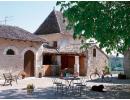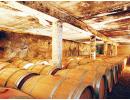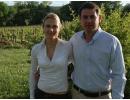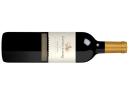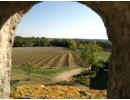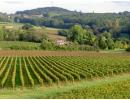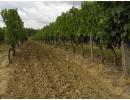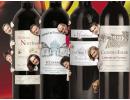Chateau Laulerie
Château Laulerie "Fûts de Chênes” 2012 - Bergerac
This is the main premium wine of the estate. The blend is 60% Merlot with Cabernet Franc and Malbec. The percentage in the blend of the latter 2 grape varieties will depend on the vintage's potential. The grapes are destemmed and the fermentations last about 3 weeks in stainless steel vats at 28°C, this process includes the malolactic fermentations. The wine is aged in french oak barrels of 225 litres for 12 months: 6 months in new french oak barrels, then a further 6 months in 50 hl oak vats. This method of ageing the wine will give it time to open up and to find its harmony and integrate some of the oak tannins.
PVins notes: The nose is very expressive, with dark red fruit, mixed with spice aromas and hints of toast in its youth from the oak, well-balanced and structured with a long finish. It is recommended to cellar the wine for a couple of years up on its release for the tannins to smooth out a little. The wine may be cellared for up to 10 years.
Press/Awards: Wine Enthusiast 89
A ripe wine, this shows the richness of the 2009 vintage. The tannins are well integrated into the blackberry fruit, creating a smooth and opulent wine that’s worth aging but is also ready to drink now.
Other wines produced by the family Dubard are Château Nardou - Francs Côtes de Bordeaux, Château La Croix Romane - Lalande de Pomerol and Dubard - Crémant de Bordeaux.
Château Laulerie is located in the western part of the Bergerac region at Saint-Méard-de-Gurçon at the lieu-dit "Gouyat", near the appellation Montravel. The name of Montravel in Latin “In Monte Revelationem” (Sur le Mont, Revelation) meaning “on the Mont revelation” evokes a beautifully hilly landscape. Dubard Vineyards started with the brothers Serge and Olivier in 1977. They purchased a Perigordian farm “Gouyat” with an 18th century courtyard and its 20 ha of vines. Serge Dubard, then a young oenologist graduated from the University of Bordeaux, with his brother Olivier who already has experience in agriculture, implemented their technical knowledge in the vineyard and cellar. Emphasis is given to innovation by renovating the cellar, improving viticultural technics and investing in oenological equipment with the the challenge of producing quality wines. They turned their backs on selling their wines in bulk and chose to engage in selling estate bottled wines and also increase the sales on the export markets. The new parcels of vines purchased to increase the size of the vineyards are selected on the basis of the best exposed terroirs. The plantations are conducted at high density which was contrary to local customs at the time. In 1986, their sister Irene who has an accounting background joined her brothers in looking after the administrative side of the family business. In 1994, the respective spouses of Serge and Irene reinforced the team. Serge's wife Betty looks after business sales and Jean Pascal, Irene's husband managers the vineyard.
Since 2004, a new chapter has started with the arrival of Olivier's son Gregory after completing his diplomat in Agricultural Engineering and Oenology, he represents the 2nd generation. Gregory has spent a few months in the Italian and New Zealand vineyards for work experience. His wife Marine is now also involved in the "Vignobles Dubard" family business looking after the sales and marketing of the various estates of the family.
The family has expanded its vineyards by purchasing a number of châteaux, including some outside the Bergerac Region in neighbouring Bordeaux. In 1998, the third brother Florent Dubard purchased Château Nardou (15 ha) in Francs Côtes de Bordeaux. In 2000, Serge purchased Château Les Farcies du Pech (10 ha) in Pécharmant near the town Bergerac. In 2008, the family realized a project and a dream with the acquisition in Lalande de Pomerol of the Clos de l'Eglise renamed Château La Croix Romane (7.70 ha) which Gregory managers. In 2011, the family purchased another estate in the Bordeaux region Château Bel-Air (8.34 ha) in Puisseguin Saint-Emilion, the château is also managed by Gregory.
Today, Château Laulerie covers 85 ha of vineyards in the appellations Bergerac, Montravel, Cotes de Montravel and Haut Montravel. Its vineyards are located on a plateau overlooking the right bank of the Dordogne River. The terroir is composed of limestone overlaid by molasse of the Agenais which form gravelly hilltops sometimes covered with lacustrine limestone fossils. This warm terroir, often described as "sands and gravels of the Périgord" is also rich in flint stones. As a result, the terroir expresses itself in the white wines through minerally aromas of flintiness and richness on the palate.
The estate is planted with 56% of red grapes: Merlot, Cabernet franc, Cabernet Sauvignon and Malbec and 44% of white grapes: Sauvignon Blanc and Semillon. The vines are trained in short Simple Guyot, grass is grown every second row, the vine’s foliage is managed so that it is aerated and distributed harmoniously. This is achieved by plucking the leaves, usually in july, on the shaded side of the vines (East or North) which will provide an excellent sanitary state and phenolic maturity of the skins. This foliage management also helps to obtain small grape clusters that ripen naturally. The harvest is carried out during the night, the cooler temperatures help to keep fresh fruity aromas which will be amplified in the winemaking process.
The red grapes are de-stemmed, pre-fermentation skin macerations is carried out for a few days, fermentations are done in stainless steel vats over 3 weeks at 28°C. Depending on the red wine produced, they will either be aged in stainless steel vats for early drinking on the fruit, while the premium wines are barrel aged with the aim to be cellared over 10 to 15 years, like any well made wines from the Bordeaux region. The blend for reds is Merlot based with Cabernet Franc and Malbec. The cuvée "Fûts de Chêne" is aged for 12 months with 50% in new french oak barrels of 225 litres and 50% in oak vats of 50 hl. The vines which are 30 years old on average produce a yield of 45 hl/ha. The wine's volume represents 20 ha of vines planted on clayey-limestone soil. Another premium red wine produced by the estate is the cuvée "Comtesse de Ségur" from the neighbouring appellation Montravel.
As for the whites produced they are mainly Sauvignon Blanc based with some Semillon. The premium white wine from the Montravel appellation is named "Comtesse de Ségur". Winemaking technics are classic, with pre-fermentation skin macerations for the white grapes in stainless steel vats at a cold temperature of around 10°c. This process will last 6 to 12 hours depending on the vintage to extract extra flavours, colour and structure. The premium wine from Montravel is aged in oak barrels for 10 months while the white Bergerac is aged in stainless steel vats for 6 months on fine lees. The wines are very similar to those of the Graves region of Bordeaux.
Links: South West map - www.vins-bergerac.fr
BERGERAC
The appellation Bergerac was created in 1936. Bergerac is also a sub-region of the South West France area, it comprises a total of 13 appellations located around the town of Bergerac in the Dordogne Department. The town of Bergerac, which is divided in 2 by the Dordogne River, is located about 100 kilometres to the east Bordeaux. As a sub-region it represents a total of 12,800 hectares of vineyards. The various appellations vary in size from 125 hectares for the Rosette to 9,200 hectares for the appellation Bergerac. The numerous appellations offer various styles of wines, from dry whites Montravel, Bergerac Sec to medium-sweet Cotes de Montravel, Cotes de Bergerac Moelleux, Rosette and sweet wines Montbazillac, Saussignac and Haut-Montravel. The reds are found in the appellations of Bergerac, Cotes de Bergerac, Pécharmant, Montravel which account for half of the volume of wines produced in the region, Bergerac Rosé is also produced.
History
The viticultural history is similar to the neighbouring wine region of Bordeaux, the cultivation of vines began with the arrival of the Romans. The fall of the Roman Empire had few adverse effects on wine-growing as the new Visigoths settlers were great wine drinkers. Since 1254 Bergerac has been exporting its wines, it began with shipments to England via the port of Bordeaux based on special privileges granted by Henry III of England, as the region of Aquitaine was under English rule at the time.
Vineyard
As for the terroirs, the multiple layers of geological substrate formed since the early tertiary period have given the region a great diversity of soil structures, with clay and limestone being the main components. On the left bank of the Dordogne, south of Bergerac, the lacustrian calcareous bed rock of the south-eastern area produces brown soil containing calcareous pebbles. To the north, on the right bank of the Dordogne River, the bed rock contains sands and clays mixed with gravel. To the west around the Montravel area, calcareous bed rock that was once the sea floor produces brown soil containing calcareous pebbles. These are the same soils as those found in the eastern vine-growing region of Bordeaux such as Saint-Émilion, Côtes de Castillon and Côtes de Franc. Also during the Quaternary period, when the Dordogne River was carving its way through the region, it deposited terraces of alluvial gravel coming down from the Massif Central Mountains. These gravel deposits in the structure of the soil provide very good drainage.
The main grape varieties used in the appellations of this sub-region are the same as in neighbouring Bordeaux with a couple of exceptions. The red wines are a blend of Cabernet Sauvignon, Cabernet Franc and Merlot, sometimes supplemented by Malbec or less commonly by Fer Servadou. The Begerac appellation reds are Merlot dominant. They are often dark in colour, fruity and medium-bodied very similar to Bordeaux, the better ones can rival with some of the Cru Bourgeois from the Médoc region. The white wines are mainly a blend of Semillon with Sauvignon Blanc and Muscadelle, to which Ugni blanc, Ondenc and Chenin blanc are sometimes added except for the appellation Bergerac. These combinations lead to the creation of fruity dry whites and also medium-sweet to sweet wines that are aromatic and rich. Bergerac as a sub-region can be considered to be the little brother of Bordeaux as the wines are very similar in style.
Climate
The Bergerac climate is temperate oceanic with continental influences. The western part of the appellation bordering the Bordeaux region around Montravel, has the same oceanic climate conditions as Saint Emilion. While the eastern part of the appellation Bergerac, the heart of the appellation, has a continental climate. The Dordogne River also has an influence in the local climate. The month of April is humid which boosts vine growth and helps to prevent disastrous spring frosts. The summers are warm and relatively dry, while moderate humidity is carried by the westerly winds from the Atlantic Ocean. In October, the foggy mornings and sunny afternoons promote the development of botrytis (noble rot), which is vital in the making of dessert wines.



